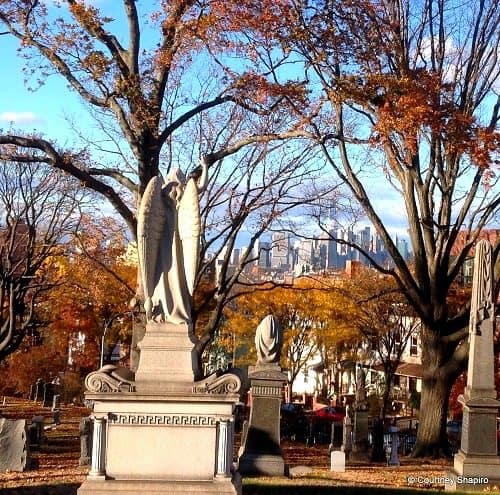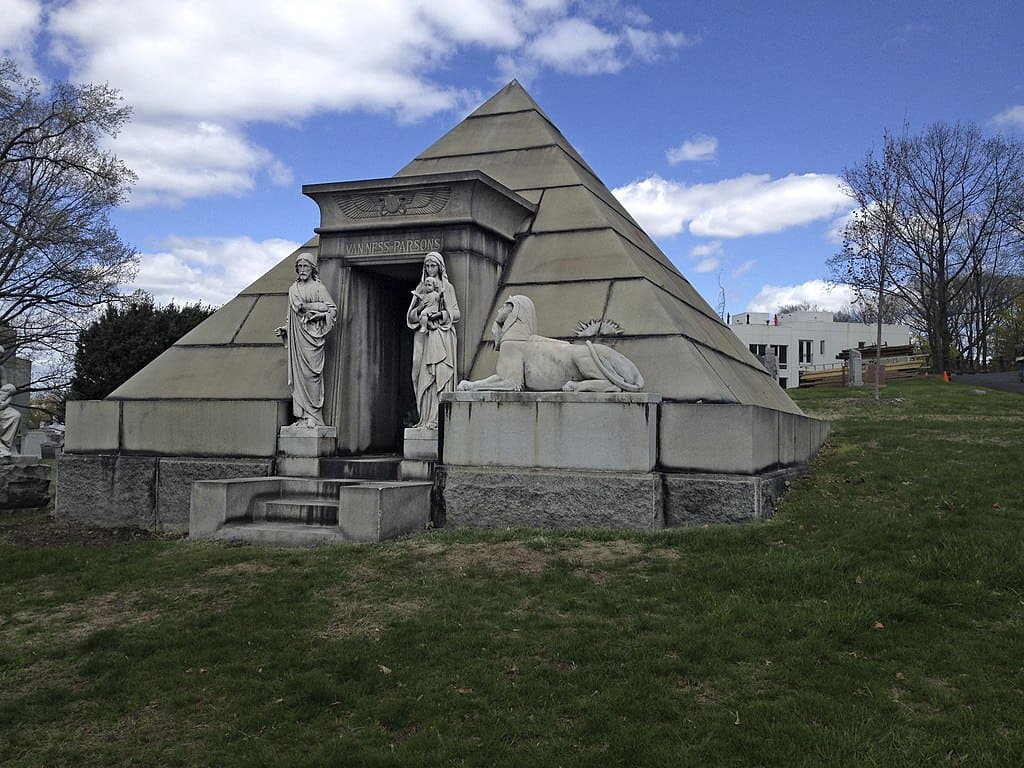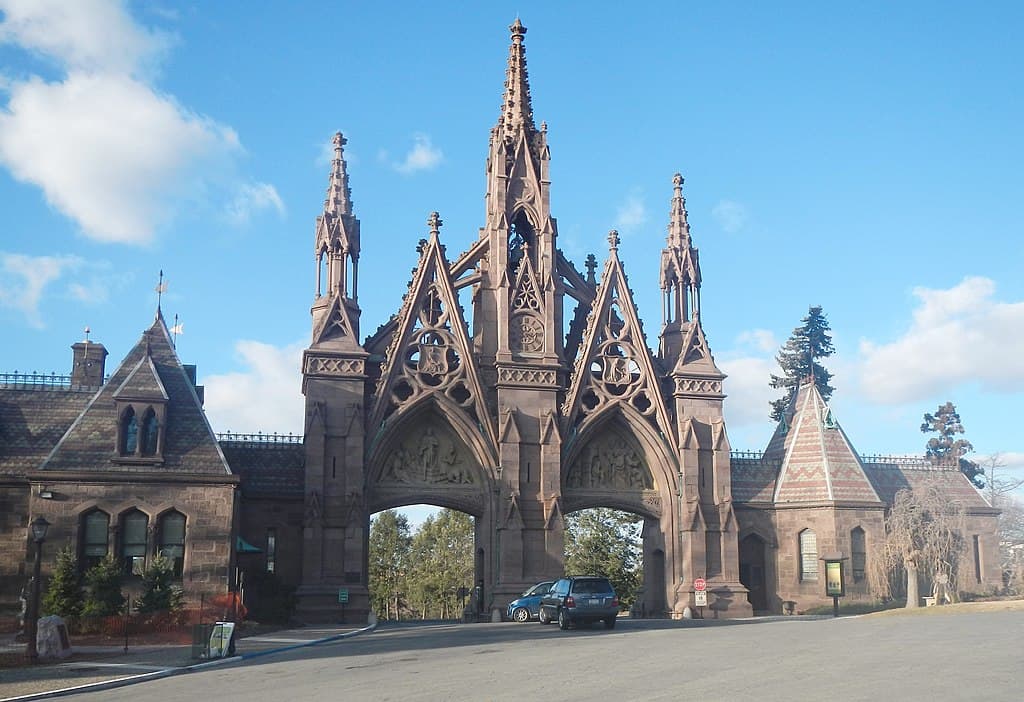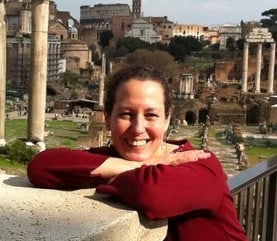This post explains how you can take a tour of Green-wood Cemetery in Brooklyn, both guided as well as self-guided tours. Admission is free every day.
- Introduction
- Who is Buried Here
- Guided Tours
- Self-Guided Tour
- Hours and Directions
- Things to Do in Brooklyn
Introduction
Opened in 1838, over half a million people are buried in Green-wood Cemetery.
Among them are many notable Americans (see below) and over 5,000 fallen civil war soldiers.
The land that Green-wood is on was the site of the first Revolutionary War battle, the Battle of Long Island. A few heroes of the Revolutionary War are buried here.
There are also individuals buried here who you've never heard but whose life stories and tales of their demise make a tour of Green-wood really fascinating.
Green-wood is also one of the most beautiful cemeteries in the U.S. The views are wonderful and you can see all the way to Lower Manhattan.

There are grand public monuments, as well as stunning family shrines, private mausoleums, and even catacombs.
Some consider it to be one of the finest 19th-century and 20th-century "open-air galleries" of neo-renaissance, neoclassical, and Victorian-style statues.
Because of its historic significance as well as its beautiful monuments, headstones, and landscaping, a tour of Green-wood Cemetery will not disappoint.
Read more about its history below. To find out about taking a tour, see the tour section further down in this post.
Who Is Buried Here?
Many influential Americans whose contributions and innovations changed the world are buried in Green-wood Cemetery.
There are countless Civil War soldiers and some Generals.
There are also some Revolutionary War heroes and even a 'founding father', William Livingston (1723–1790), a signer of the U.S. Constitution and first Governor of New Jersey.

Here are some of the other notable individuals buried in Green-wood:
Political and Public Figures
- Rev. Henry Ward Beecher (1813-1887), Pastor of Plymouth Church in Brooklyn Heights and nationally-known abolitionist
- Peter Cooper (1791–1883), inventor, manufacturer, abolitionist, and founder of Cooper Union in the East Village
- DeWitt Clinton (1769–1828), seventh and ninth Governor of New York, and US Senator from New York
Famous Women
- Susan McKinney Steward (1847–1918 ), the third African-American woman to earn a medical degree, and the first in New York state
- Mary Jacobi (1842-1906), physician, teacher, scientist, writer, and suffragist
- Abigail Hopper Gibbons (1801-1893), abolitionist, schoolteacher, and social welfare activist
- Laura Keene (1826-1873), 19th-century actress who was on stage during Lincoln’s assassination
- Kate Claxton (1848-1924), performer on stage during the Brooklyn Theater fire of 1876
- Isabella Goodwin (1865-1943), first woman detective in the New York Police Department
Inventors
- Elias Howe (1819–1867), sewing machine
- Samuel F. B. Morse (1791–1872), the telegraph and Morse code
- Walter Hunt (1785–1869), safety pin
- Charles Feltman (1841–1910) - said to be the first person to put a hot dog on a bun
Cultural Figures
- Jean-Michel Basquiat (1960–1988), artist and muralist, part of the SoHo art scene in the early 1980s
- Eastman Johnson (1824–1906), co-founder of the Metropolitan Museum of Art
- Frederick August Otto Schwarz (1836–1911), founder of famed toy store FAO Schwarz
- Leonard Bernstein (1918–1990), conductor of the NY Philharmonic, based in Carnegie Hall and then Lincoln Center
- Louis Comfort Tiffany (1848–1933), known for his stained glass windows, such as the Tiffany Clock in Grand Central Terminal
Baseball Figures
- James Creighton, Jr. (1841–1862), the first pitcher to throw a fastball
- Charles Ebbets (1859–1925), owner of the Brooklyn Dodgers baseball team, built Ebbets Field
- Henry Chadwick (1824–1908), Baseball Hall of Fame member
Gangsters and Mobsters
- Albert Anastasia (1903–1957), mobster and contract killer for Murder, Inc.
- “Crazy” Joey Gallo (1929–1972), a member of the Columbo crime family, shot down in Little Italy
- William "Bill the Butcher" Poole (1821–1855), leader of the notorious Bowery Boys gang in Five Points
Newspaper Publishers
- Horace Greeley (1811–1872), founder of the New York Tribune
- James Gordon Bennett, Sr. (1795–1872), founder/publisher of the New York Herald
- Henry Jarvis Raymond (1820–1869), founder of the New York Times
Guided Tours
Green-wood Cemetery offers a Historic Trolley for $30 per person. Tours are running as of Summer 2024 on Saturdays from 1 pm - 3 pm.
You are accompanied by an expert tour guide who will share the intriguing stories of the more notable permanent "residents".

Book your tour here. These tours routinely sell out so reserve tickets in advance.
Green-wood also has special events, such as occasional nighttime events, or tours of the Catacombs.
See the Green-wood Cemetery Events Calendar to find out what's scheduled while you are here.
Self-Guided Tours
Admission to Green-Wood is free at all times, and free maps are available at the entrance at 5th Avenue and 25th Street in Brooklyn.
You can download this free pdf version of a map of Green-Wood or download their free Mobile App.
Hours and Directions
Directions
See the Green-wood Cemetery website for detailed directions.
Hours
Green-wood is open 7 days a week. Hours vary by season and by entrance. Here are the entry points and hours they are open:
Main Entrance (Fifth Avenue and 25th Street) 7 am to 7 pm
Sunset Park Entrance (Fourth Avenue and 35th Street) 8 am to 7 pm
Fort Hamilton Parkway Entrance (Fort Hamilton Parkway and Micieli Place) and Prospect Park West Entrance (Prospect Park West and 20th Street) will each be open from 11 am to 7 pm Monday through Friday (pedestrian gate only). On Saturday and Sunday, gates are open 8 am to 7 pm (pedestrian gate) with vehicle admittance from 8 am to 4pm.
History of Green-wood Cemetery
In America until the 1830s, burials were located in graveyards -- small plots of land usually belonging to the adjacent church or a town hall.
New York City’s Trinity Church and St. Paul’s Chapel in Lower Manhattan both have graveyards that date back to pre-Revolutionary times.
According to maps of early 1800s Manhattan, there were at least a dozen small graveyards below 12th Street, but these tended to be reserved for the deceased of wealthy or well-connected families.
Meanwhile, immigrants began arriving in New York City by the tens of thousands and as the city’s living population soared, so did the need for more space to bury its dead.
City planners began to address this issue and one major obstacle was the lack of space and the high real estate prices within New York City (which until 1898 was only the Island of Manhattan). City planners had to look for land located beyond the city limits.
At the same time, cities like Paris and Boston were experimenting with a new kind of cemetery, designed to be pastoral, serene and airy, unlike the cramped, dreary city graveyards.
The earliest grand and intentionally “rural” cemeteries were Pere Lachaise in Paris (1806) and Mount Auburn in Boston (1831).
In stepped Henry Pierrepont, a prominent and wealthy resident of the City (now borough) of Brooklyn, then one of the most important cities in the world.
Pierrepont felt strongly that the 300,000 residents of Brooklyn deserved a cemetery of grandeur, far removed from the hustle and bustle of city life, and that would offer both a serene setting for afternoon strolls for the living and eternal homes to Brooklyn’s dearly departed.
A board of trustees was formed and 478 acres of farmland in Brooklyn were purchased. With Pierrepont’s influence, engineer and designer Major David Bates Douglass was commissioned to develop Green-wood. The result was magnificent.
Located on the highest peaks in Brooklyn, Green-wood was more like a grand English park, with its rolling hills, natural ponds, and walking paths that wind through expanses of lush green lawns dotted with flowers and succulents, sculptures and architectural monuments
Green-wood's landscaping was so exceptional that it served as an inspiration to Calvert Vaux, the designer of Central Park and Prospect Park.
Ironically, what Green-wood didn’t inspire were customers.
Despite the splendor and space, it offered for burials, its potential clientele mainly lived in Manhattan and would have to be ferried over for burial.
In Green-wood’s early years there was a reluctance by New Yorkers to purchase plots in Distant Brooklyn.
Then, in 1844, the cemetery’s trustees devised a brilliant public relations stunt that gave the cemetery instant celebrity status.
They arranged to move the body of a multi-term New York mayor, U.S. Senator, and Governor, DeWitt Clinton, (who died in 1828) from his modest Albany grave to a new site at Green-Wood.
Soon the cemetery was selling huge plots of land for tombs, shrines, and even mausoleums and catacombs to families of the ‘rich and famous’ in anticipation of the inevitable.
Within 20 years of its opening, Green-wood was just as popular with the living as it was with the dead.
It attracted 500,000 visitors a year, rivaling only Niagara Falls for the greatest number of tourists.
When you visit Green-wood it is easy to understand why people flocked here to stroll and even picnic on the grass.
Green-wood is a feast for the eyes, with an abundance of finely-sculpted headstones that tell the stories of those who lie beneath them.






